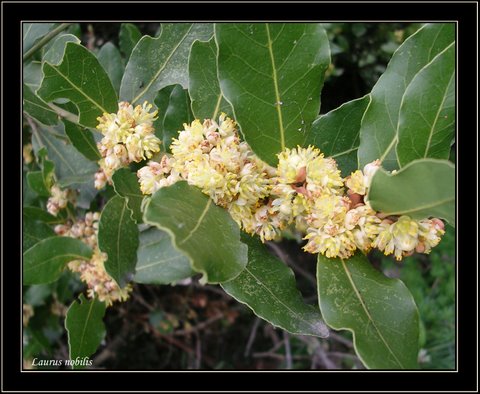
Bay is as aromatic, ever green tree of medium size, with shiny gray bark. It produces a four-lobed calyxes, greenish yellow in small umbels from the leaf axils. The leaves are shiny, thick, leathery and dark green with wavy edges and the plant produces a fruit that is dark purple or black berry the size of a grape. The plant is indigenous to the Mediterranean region and Asia Minor and is cultivated in Turkey, Algeria, Belgium, France, Greece, Mexico, Morocco, Portugal, Spain, the Canary Islands, Central America and the southern part of the United States.
Romans believed years ago that the plant could keep you safe from thunder and lightning. I have a hard time believing that one, since our property was hit with lightning two years in a row a number of years ago. We had to take down 2 huge pine trees that was the home for hawks and we had to replace a number of appliances/electronics. They also used the plant to symbolized greatness, honor and glory as it was wore to crown the kings, priests, poets, victors of battles, athletic or scholarly contests
If you are thinking of having your own bay leaf plant, have it potted so that you can bring it indoors during the winter. I have one that is about 17 years old and I bring it outdoors late spring and during the winter, I bring it inside the house. Make sure you do not over water and that it has plenty of sunlight. Make sure that you are purchasing the laurus nobilis variety, since there are a number of different species of the plant.
In the kitchen, Bay can be used in just about any soup, stew or tomato sauce recipe. They are great in shell fish boils, pickling brines and with game. Add them when cooking beans, lentils, rice and tuck a bay leaf or two in the cavity of a chicken before roasting. Use them in combination with peppercorns, saffron, garlic, allspice, citrus and dried mustard seeds. Just remember to take them out of your recipe, before serving, since the bay leaf has sharp edges that can be painful in the throat.
Other uses: some people believe that it is an insect repellent and place a leaf in their flour or cereal box and will crumble some during the spring to detour ants from entering the house. You can also make a light infusion, using about 8 medium size leaves in boiling water, let it steep and add it to the bath. The oils of the leaves soothes the skin.
So the next time you are cooking, try adding a bay leaf and see the difference in flavor.
******Above information is for educational purposed only. Like any medication, consult your doctor when using herbs for medicinal purposes.******

